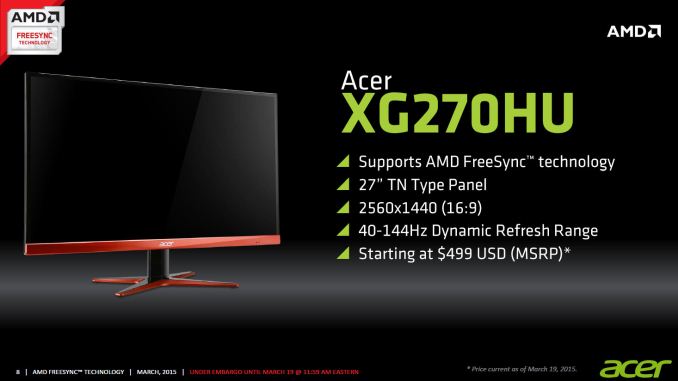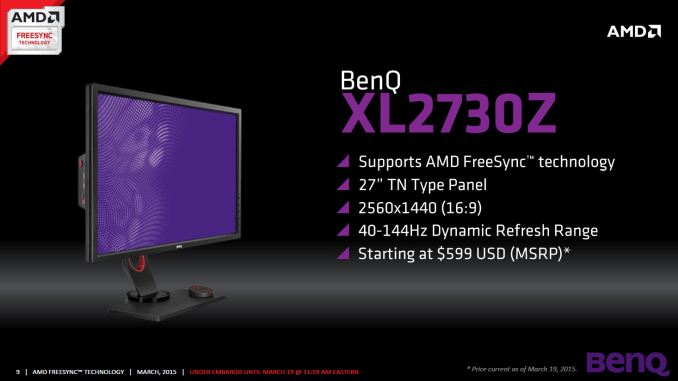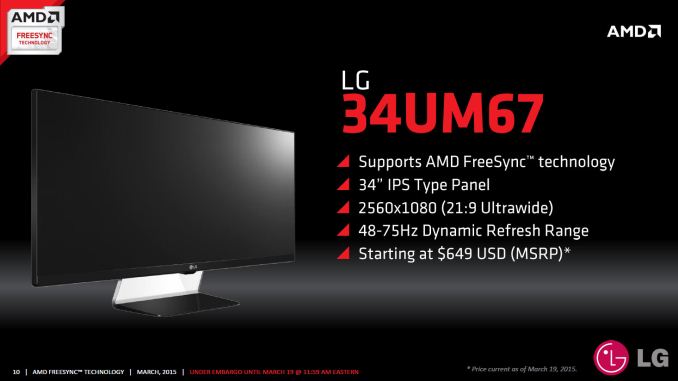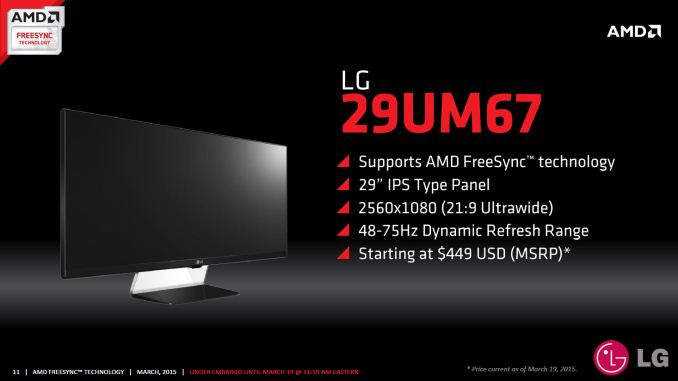The AMD FreeSync Review
by Jarred Walton on March 19, 2015 12:00 PM ESTFreeSync Displays
There are four FreeSync displays launching today, one each from Acer and BenQ, and two from LG. Besides the displays launching today, seven additional displays should show up in the coming weeks (months?). Here’s the current list of FreeSync compatible displays, with pricing where it has been disclosed.
| FreeSync Compatible Displays | ||||||
| Manufacturer | Model | Diagonal | Resolution | Refresh | Panel | Price |
| Acer | XG270HU | 27" | 2560x1440 | 40-144Hz | TN | $499 |
| BenQ | XL2730Z | 27" | 2560x1440 | 40-144Hz | TN | $599 |
| LG Electronics | 34UM67 | 34" | 2560x1080 | 48-75Hz | IPS | $649 |
| LG Electronics | 29UM67 | 29" | 2560x1080 | 48-75Hz | IPS | $449 |
| Nixeus | NX-VUE24 | 24" | 1920x1080 | 144Hz | TN | ? |
| Samsung | UE590 | 28" | 3840x2160 | 60Hz | TN | ? |
| Samsung | UE590 | 23.6" | 3840x2160 | 60Hz | TN | ? |
| Samsung | UE850 | 31.5" | 3840x2160 | 60Hz | TN? | ? |
| Samsung | UE850 | 28" | 3840x2160 | 60Hz | TN? | ? |
| Samsung | UE850 | 23.6" | 3840x2160 | 60Hz | TN? | ? |
| Viewsonic | VX2701mh | 27" | 1920x1080 | 144Hz | TN | ? |
The four displays launching today cover two primary options. For those that want higher refresh rates, Acer and BenQ have TN-based 40-144Hz displays. Both are 27” WQHD displays, so it’s quite probable that they’re using the same panel, perhaps even the same panel that we’ve seen in the ASUS ROG Swift. The two LG displays meanwhile venture out into new territory as far as adaptive refresh rates are concerned. LG has both a smaller 29” and a larger 34” 2560x1080 (UW-UXGA) display, and both sport IPS panels (technically AU Optronics' AHVA, but it's basically the same as IPS).
The other upcoming displays all appear to be using TN panels, though it's possible Samsung might offer PLS. The UE590 appears to be TN for certain, with 170/160 degree viewing angles according to DigitalTrends. The UE850 on the other hand is targeted more at imaging professionals, so PLS might be present; we'll update if we can get any confirmation of panel type.
One of the big benefits with FreeSync is going to be support for multiple video inputs – the G-SYNC displays so far are all limited to a single DisplayPort connection. The LG displays come with DisplayPort, HDMI, and DVI-D inputs (along with audio in/out), and the Acer is similarly equipped. Neither one has any USB ports, though the BenQ does have a built-in USB hub with ports on the side.
Our testing was conducted on the 34UM67, and let me just say that it’s quite the sight sitting on my desk. I’ve been bouncing between the ASUS ROG Swift and Acer XB280HK for the past several months, and both displays have their pros and cons. I like the high resolution of the Acer at times, but I have to admit that my aging eyes often struggle when running it at 4K and I have to resort to DPI scaling (which introduces other problems). The ASUS on the other hand is great with its high refresh rates, and the resolution is more readable without scaling. The big problem with both displays is that they’re TN panels, and having come from using a 30” IPS display for the past eight years that’s a pretty painful compromise.
Plopping the relatively gigantic 34UM67 on my desk is in many ways like seeing a good friend again after a long hiatus. “Dear IPS (AHVA), I’ve missed having you on my desktop. Please don’t leave me again!” For the old and decrepit folks like me, dropping to 2560x1080 on a 34” display also means reading text at 100% zoom is not a problem. But when you’re only a couple feet away, the relatively low DPI does make the pixels much more visible to the naked eye. It even has built-in speakers (though they’re not going to compete with any standalone speakers in terms of audio quality).
The launch price of $649 is pretty impressive; we’ve looked at a few other 21:9 displays in the past, and while the resolution doesn’t match LG’s 34UM95, the price is actually $50 less than the LG 34UM65’s original $699 MSRP (though it’s now being sold at $599). So at most, it looks like putting in the new technology to make a FreeSync display costs $50, and probably less than that. Anyway, we’ll have a full review of the LG 34UM67 in the coming weeks, but for now let’s return to the FreeSync discussion.
Pricing vs. G-SYNC
It certainly appears that AMD and their partners are serious about pricing FreeSync aggressively, though there aren’t direct comparisons available for some of the models. The least expensive FreeSync displays start at just $449, which matches the least expensive G-SYNC display (AOC G2460PG) on price but with generally better specs (29” 2560x1080 and IPS at 75Hz vs. 24” 1920x1080 TN at 144Hz). Looking at direct comparisons, the Acer XG270HU and BenQ XL2730Z are WQHD 144Hz panels, which pits them against the $759 ASUS ROG Swift that we recently reviewed, giving FreeSync a $160 to $260 advantage. As AMD puts it, that’s almost enough for another GPU (depending on which Radeon you’re using, of course).
Based on pricing alone, FreeSync looks poised to give G-SYNC some much needed competition. And it’s not just about the price, as there are other advantages to FreeSync that we’ll cover more on the next page. But for a moment let’s focus just on the AMD FreeSync vs. NVIDIA G-SYNC ecosystems.
Right now NVIDIA enjoys a performance advantage over AMD in terms of GPUs, and along with that they currently carry a price premium, particularly at the high end. While the R9 290X and GTX 970 are pretty evenly matched, the GTX 980 tends to lead by a decent amount in most games. Any users willing to spend $200 extra per GPU to buy a GTX 980 instead of an R9 290X might also be willing to pay $200 more for a G-SYNC compatible display. After all, it’s the only game in town for NVIDIA users right now.
AMD and other companies can support FreeSync, but until – unless! – NVIDIA supports the standard, users will be forced to choose between AMD + FreeSync or NVIDIA + G-SYNC. That’s unfortunate for any users that routinely switch between AMD and NVIDIA GPUs, though the number of people outside of hardware reviewers that regularly go back and forth is miniscule. Ideally we’d see one standard win out and the other fade away (i.e. Betamax, HD-DVD, etc.), but with a one year lead and plenty of money invested it’s unlikely NVIDIA will abandon G-SYNC any time soon.
Prices meanwhile are bound to change, as up to now there has been no competition for NVIDIA’s G-SYNC monitors. With FreeSync finally available, we expect prices for G-SYNC displays will start to come down, and in fact we’re already seeing $40-$125 off the original MSRP for most of the G-SYNC displays. Will that be enough to keep NVIDIA’s proprietary G-SYNC technology viable? Most likely, as both FreeSync and G-SYNC are gamer focused more than anything; if a gamer prefers NVIDIA, FreeSync isn’t likely to get them to switch sides. But if you don’t have any GPU preference, you’re in the market for a new gaming PC, and you’re planning on buying a new monitor to go with it, R9 290X + FreeSync could save a couple hundred dollars compared to GTX 970 + G-SYNC.
There's something else to consider with the above list of monitors as well: four currently shipping FreeSync displays exist on the official day of launch, and Samsung alone has five more FreeSync displays scheduled for release in the near future. Eleven FreeSync displays in the near term might not seem like a huge deal, but compare that with G-SYNC: even with a one year lead (more or less), NVIDIA currently only lists six displays with G-SYNC support, and the upcoming Acer XB270HU makes for seven. AMD also claims there will be 20 FreeSync compatible displays shipping by the end of the year. In terms of numbers, then, DP Adaptive Sync (and by extension FreeSync) look to be winning this war.


























350 Comments
View All Comments
SleepModezZ - Thursday, March 19, 2015 - link
Really different reviews between AnandTech and PC Perspective. You conclude that FreeSync performs as well as G-Sync - if not better, because of the option to disable V-sync. PC Perspective, on the other hand, noticed that their FreeSync monitors performed badly compared to the G-Sync monitors when the frame rate dropped below the lowest refresh rate of the monitor.You give the impression that they would behave the same - or FreeSync would be potentially better because you could choose your poison: stutter or tearing - when with G-Sync you would always get stuttering. PC Perspective, on the other hand, tells that G-Sync monitors handle this gracefully by refreshing the display twice or more during those longer frames - and as such G-Sync avoids both stutter and tearing at those lower fram rates. Their FreeSync monitors did not do that - and the stuttering or tearing was very noticeable. The frame rate dropping below 48 fps is not uncommon and the displays behavior in those situations is very important. That makes the G-Sync the superior technology. Unless - the tearing or stuttering at speeds lower than the display's lowest refresh rate is only a problem with that specific monitor and not with the FreeSync / AdaptiveSync technology in general. (The LG monitor is incapable of doubling its slowest refresh rate - other monitors that are capable maybe could handle the situation differently. If not, FreeSync is the inferior technology.)
I don't know how G-Sync and FreeSync actually would handle full screen movies at 24 fps. G-Sync could easily display it at a 48 Hz refresh rate. Your LG monitor would probably also show it at 48 Hz - because it is the lowest it could go. But would the LG monitor with FreeSync be smart enough to show a 25 fps movie in 50 Hz - or would it display it in 48 Hz with unnecessary tearing or stuttering?
Gigaplex - Friday, March 20, 2015 - link
"PC Perspective, on the other hand, tells that G-Sync monitors handle this gracefully by refreshing the display twice or more during those longer frames - and as such G-Sync avoids both stutter and tearing at those lower fram rates."That would drastically reduce the effects of tearing, but it would not do much, if anything, for stutter.
SleepModezZ - Friday, March 20, 2015 - link
It would reduce stutter in the sense that if the frame rate were, for example, constantly 30 fps, G-sync would give you every frame when it is ready - keeping the motion fluid. FreeSync with V-SYnc on, on the other hand, would force that into the lowest refresh rate of the monitor. It would double some frames and not others - making the timing of the frames different and making a constant 30 fps motion jerky where G-Sync would not. I would call that jerky motion 'stutter' - FreeSync (currently) has it, G-Sync does not.In short, G-Sync retains its variable refresh rate technology when going under the displays min refresh rate. FreeSync does not but switches to constant refresh rate at the monitors min refresh rate - introducing either tearing or stutter. Within the display's refresh rate range they perform the same. When going faster than the refresh rate range - FreeSync gives the option of disabling V-Sync and choosing tearing instead of stuttering. There it is better. I just think that the low fps range is probably more important than the high. I would not buy any FreeSync / Adaptive Sync displays before they demonstrate that they can handle those low fps situations as gracefully as G-Sync does.
WatcherCK - Thursday, March 19, 2015 - link
TFTcentral have done a review of the soon to be released Acer monitor:http://www.tftcentral.co.uk/reviews/acer_xb270hu.h...
And as Ryan said it is a beast, but one question you buy an XB270hu and you plug in your 290x, because the video card doesnt support GSYNC uses the standard scaler? in the Acer to display video data. Now if the Acer uses a scaler from one of the four main manufacturers listed in the article is there a chance it would support Freesync? (Acer wouldnt advertise that obviously since the monitor is a GSYNC branded monitor....)
So there are a few assumptions above about the operations of GSYNC, but Im curious if this will be the case as it keeps red and green camps happy...
One other question if anyone is happy to answer, high hertz refresh monitors will they maintain their peak capable refresh when in portrait mode or are they limited to a lower refresh rate or GSYNC for that matter? Im thinking a triple monitor portrait setup for my next build.
cheers
sonicmerlin - Thursday, March 19, 2015 - link
Will Freesync work with the current gen consoles?SleepModezZ - Thursday, March 19, 2015 - link
No.Adaptive Sync is a Display Port specific standard. What current gen console supports Display Port? None to my knowledge. HDMI is a different standard and I don't think there have been even any rumors about putting adaptive sync technology into the HDMI standard. And if it some day would come - would the current HDMI hardware on the consoles be able to support it after a driver update from AMD? Probably not.
Murloc - Thursday, March 19, 2015 - link
it's not likely to happen any time soon since video and STBs etc. revolve around the usual framerates and TVs do the same so there's no need for this kind of flexibility, tearing is not an issue.Too bad that TV standards like HDMI spill over in the computer world (audio, projectors, laptops, etc.) and hamstring progress.
sonicmerlin - Friday, March 20, 2015 - link
Well what if MS and Sony released hardware refreshes (like a slimmed down PS4) that included display port?Gigaplex - Friday, March 20, 2015 - link
I'm pretty sure that both Xbox One and PS4 use GCN 1.0 hardware, so no, a DisplayPort refresh probably wouldn't help.Norseman4 - Thursday, March 19, 2015 - link
Can you please verify some information:On the specs page for the BenQ XL2730Z (http://gaming.benq.com/gaming-monitor/xl2730z/spec... it states a 54Hz min vertical refresh. This could be a copy/paste issue since it's the same as the min horizontal refresh.